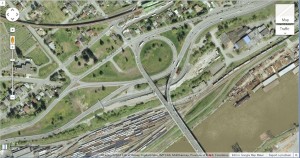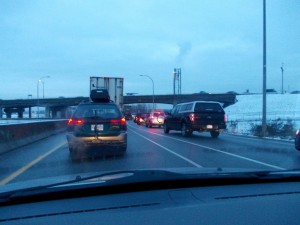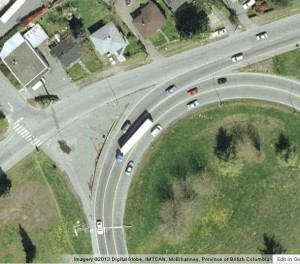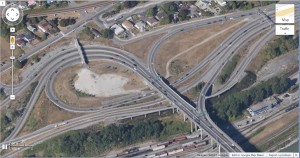I’m really going out on a limb on this one. I’ve said some unpopular things in the past, but this might be the one that ends my blog, and has me run out of town on the end of a burning pitchfork. Against the advice of all whom I respect and trust, I am just going to come right out and say this:
The intersection at the north foot of the Queensborough Bridge functions as well as possible, and could not possibly work better.
I know what you are saying now. It is a fiasco! The last fix was good money thrown against bad! A perfect example of how engineers have no idea what they are doing! An epic boondoggle that has ruined our City for a generation! The cause of the region’s (if not the world’s) worst traffic quagmire!
I suggest this well-worn trope is not true. I do not do this lightly, because I know it is a sore point for people stuck in the queue down 20th every morning, or the people stuck in the Sixth Ave access awaiting light cycles that seem red for 5 minutes and green just long enough to let three cars through, or the people lining up in the right lane on Stewardson behind the endless line of container trucks inching towards the bridge, or even the people scooting up the left lane on Stewardson hoping that one of those trucks will open just the barest fraction of a gap they can scoot into after passing a kilometre of dupes lollygagging around in the right lane.
I commute across the Queensborough Bridge, often by car. I have been all of those people. I not only sympathize with their plight, I empathize with it. I have lived it. I just don’t agree with them that the intersection where Sixth Ave, 20th Street and Stewardson Way all come together is the problem. Or maybe I should say there is no way to change that intersection that will fix the problem.
First, the quick-and-dirty history of the Queensborough Bridge. It was originally built not as part of a freeway system, but to provide community access to the Queensborough neighbourhood back in the late 1950s. Like every other bridge of the era, the Queensborough’s construction was financed and paid by tolls. By the standards of the time, and considering it was connected to local roads at each end, the four narrow lanes and 1.2m sidewalk (all without separation barriers) were appropriate and did the job.
In the mid-1980s, the building of the Alex Fraser Bridge and the East-West Connector suddenly attached the Queensborough to a couple of bustling new freeways, so the Ministry of Transportation took over the bridge and significantly re-built the southern approach. With the SkyTrain arriving around the same time (resulting in re-configuration of Stewardson Way) and the opening of the new Marine Way (a semi-freeway that move Marine Drive traffic down into ALR lands in south Burnaby), the Queensborough was gradually morphed into dealing with “freeway” traffic loads, for which it was clearly not designed. The traffic load was mitigated somewhat by the traffic lights at Howes Street, on Marine Drive to the west of the bridge, and at the foot of 20th, but as traffic increased concomitant with the new highway capacity to the south, the queues on Stewardson and 20th became endemic (in both senses of the word).
Starting in 2003, there was a major re-design of the bridge approaches at both ends. On Howes, an overpass/exchange removed the last traffic light on Highway 91 (until the notorious 72nd Ave compromise), and on the north end, the not-to-standard loop on the east side of the bridge was replaced by a just-meeting-standards loop on the west side. There were also major re-configuring of the pedestrian access (an overpass to 22nd Street, re-opening of the east side sidewalk, hanging the sidewalk off the side to increase traffic lane widths and allow protective barriers be installed). It is, however, the re-configuration on the North abutment that causes the most consternation.
But what changed in that re-configuration?
 |
| BEFORE – click to zoom in. |
Before the change, there was exactly one lane entering the bridge from the east (combining the traffic from Stewardson Way, 20th St. and Sixth Ave.) and one from the West (off of Marine Way). The merge from the east was kind of sketchy, as through-traffic (that bypassing the bridge) from Stewardson and Sixth entered in the left lane and had to get to the right while mixing with vehicles entering from the right who are trying to get left. At the same time, they are entering a low-radius curve, and merging with traffic coming around the loop from the right.
Rather fortuitously, the orthophoto on Google Maps caught one of the big safety issues with the old configuration:
Look at the truck-trailer combo on the curve, and how the geometry of the curve makes it difficult for her to maintain her lane. With cars on both sides, people still completing merges, and the blindness of the turn for anyone in a car- this was not an optimal setup.
In the new set-up, the curve was made larger-radius, and all of the turning happens where it is a single lane, significantly increasing safety and reliability. The merges take place well before the curve, and the two sets of merges are separated by space, simplifying action for drivers. There are also barriers between the curved lanes, removing the risk of head-on impacts. There is no doubt this is a safer configuration for drivers.
But note the number of lanes entering the bridge. There is exactly one lane entering the bridge from the east (combining the traffic from Stewardson Way, 20th St. and Sixth Ave.) and one from the West (off of Marine Way). Exactly as it was before. The only difference is that the merges start further back and are more controlled.
I contend that any alleged increase in traffic back-ups on Stewardson, 20th and Sixth are not caused by the lights and re-configuration, but by all three lanes trying to fit into one lane on the bridge- a condition that existed before the changes and simply cannot be fixed without building a bigger bridge.
“But, But, it is worse now! Look at all the cars! It was never like this!”
That may be true, there may be longer lines and more vehicles now, but that has little to do with the most recent intersection changes. The proof is that the pinch point is not at the intersection or the lights, it is at the merge where everyone is trying to enter the bridge. The light cycles on Sixth seem short, but rarely does it turn yellow when there is room enough to run the intersection. The same with 20th. There is always a line-up of vehicles west of the lights, and the Stewardson Traffic is unaffected by the intersection, but is still congested.
 |
| Where the real traffic back-up is. |
The reality of the matter is that there is no way to stream more cars onto the 4-lane Queensborough Bridge. During morning and evening rush, it is at capacity. Removal of the traffic lights at 20th and Sixth will have very little effect on the queues on those roads.
This is something to keep in mind when people talk about changes on Stewardson, Front Street, or Royal Ave that are designed to “get the traffic moving”. How much will we spend to make this pinch point worse?
Ultimately, the situation on the Queensborough was improved – by allowing queue-jumping by transit buses and making the cycling and pedestrian infrastructure safer- both giving people a better alternative than sitting in traffic and getting steamed over that jerk who scooted up the open left lane and just dove in front of the container truck you have been patiently following in right for the last 10 minutes…


The Qborough Bridge rework is a classic illustration of the problem with traffic in New Westminster. You can spend an awful lot of money on road improvements in the City and not see any improvement in the overall travel time. The best you can do is move the bottleneck.
There was no surprise that traffic did not improve as a result of the project. I did follow the project when it was being planned and remember being at Council during one of the later presentations of the project planners to Council. One of the councillors asked if the project would help traffic flow in New West. The answer was; no, the only think that will help that is better transit and cycling/walking facilities. Engineers were more honest about the outcomes of their projects back then.
What the project did accomplish was more reliable commute times. Gone are the days when the bridge was closed for hours due to a flipped truck or car dangling over the edge of the bridge after rounding the corner too fast.
Also you didn’t comment on the fact that in the original plans 6th Ave was to be blocked off from access to/from the bridge. This would be helped keep traffic out of the heart of the City and made the west end very quiet. However the car-dependent types couldn’t imagine adjusting their travel patterns and complained vociferously about this aspect of the plan. Interestingly though this would have made the intersection less complicated and allowed the flows from Stewardson and 20th to go more smoothly. However, as you point out, it would have made little difference to the overall travel time as the flow is ultimately dictated by the capacity of the bridge.
I think this pedestrian/cycling improvements should not be understated. These were true capacity enhancements as many more people are now able to chose walking or cycling as a means to cross the river. Prior to the current upgrades, the bridge was seriously unwelcoming to peds and cyclists.
Patrick & Andrew, to clarify past history which had a great impact on the QB
& 20th interchange. In 1996 20th Street was completely removed by Council as a Truck Route, reasons Grade, Truck congestion. This action fostered Burnaby to build from 10th Avenue down to Marine Way & their connection to Marine Way.
.
In 1983-1984 the Highways dept. proposed to build a ramp 4.3 Million from QB Bridge across 20th to Burnaby in a Full 4 Lane Configuration, with NO
parking on East 0r West sides of 20th Street. At that time 20th had a viable
commercial district, Dogwood market, Vickys Market, Tailors, and Royal Bank. The West End Resident’s Association completely rejected that proposed and insisted on 1 lane North, 1 lane South, plus parking.
Therer was an earlier proposal to build a ring road around 23Rd st. but pressure from the Jewish Cemetary and the oncoming Skytrain nixed that.
I agree with Patrick’s observation about the merge to the QB bridge today, However if every driver could simply merge politely turn by turn, it would flow a lot better.
Uh-oh… you sound dangerously close to suggesting that the bridge is too small! Not a popular stance in New West I don’t think 🙂